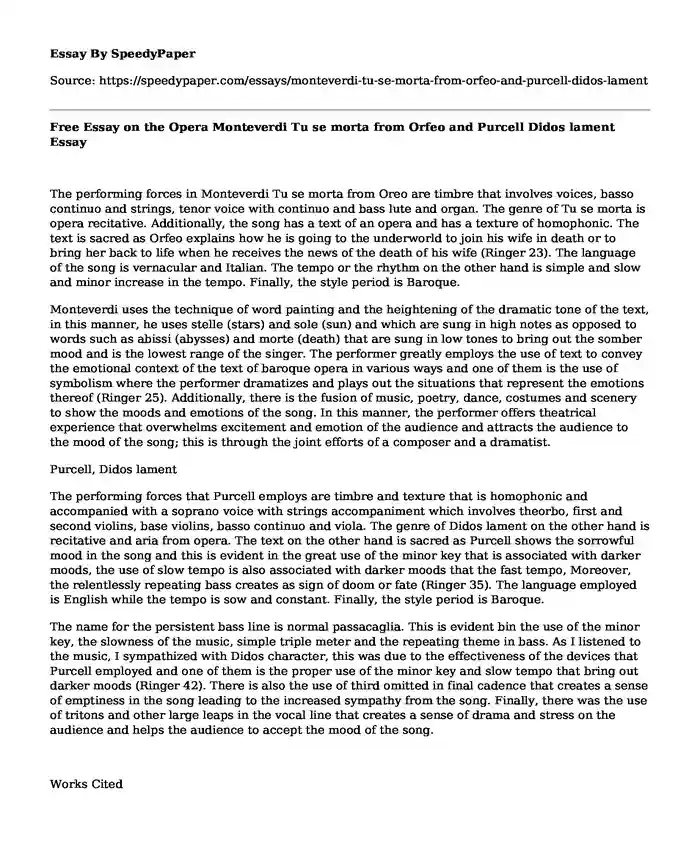The performing forces in Monteverdi Tu se morta from Oreo are timbre that involves voices, basso continuo and strings, tenor voice with continuo and bass lute and organ. The genre of Tu se morta is opera recitative. Additionally, the song has a text of an opera and has a texture of homophonic. The text is sacred as Orfeo explains how he is going to the underworld to join his wife in death or to bring her back to life when he receives the news of the death of his wife (Ringer 23). The language of the song is vernacular and Italian. The tempo or the rhythm on the other hand is simple and slow and minor increase in the tempo. Finally, the style period is Baroque.
Monteverdi uses the technique of word painting and the heightening of the dramatic tone of the text, in this manner, he uses stelle (stars) and sole (sun) and which are sung in high notes as opposed to words such as abissi (abysses) and morte (death) that are sung in low tones to bring out the somber mood and is the lowest range of the singer. The performer greatly employs the use of text to convey the emotional context of the text of baroque opera in various ways and one of them is the use of symbolism where the performer dramatizes and plays out the situations that represent the emotions thereof (Ringer 25). Additionally, there is the fusion of music, poetry, dance, costumes and scenery to show the moods and emotions of the song. In this manner, the performer offers theatrical experience that overwhelms excitement and emotion of the audience and attracts the audience to the mood of the song; this is through the joint efforts of a composer and a dramatist.
Purcell, Didos lament
The performing forces that Purcell employs are timbre and texture that is homophonic and accompanied with a soprano voice with strings accompaniment which involves theorbo, first and second violins, base violins, basso continuo and viola. The genre of Didos lament on the other hand is recitative and aria from opera. The text on the other hand is sacred as Purcell shows the sorrowful mood in the song and this is evident in the great use of the minor key that is associated with darker moods, the use of slow tempo is also associated with darker moods that the fast tempo, Moreover, the relentlessly repeating bass creates as sign of doom or fate (Ringer 35). The language employed is English while the tempo is sow and constant. Finally, the style period is Baroque.
The name for the persistent bass line is normal passacaglia. This is evident bin the use of the minor key, the slowness of the music, simple triple meter and the repeating theme in bass. As I listened to the music, I sympathized with Didos character, this was due to the effectiveness of the devices that Purcell employed and one of them is the proper use of the minor key and slow tempo that bring out darker moods (Ringer 42). There is also the use of third omitted in final cadence that creates a sense of emptiness in the song leading to the increased sympathy from the song. Finally, there was the use of tritons and other large leaps in the vocal line that creates a sense of drama and stress on the audience and helps the audience to accept the mood of the song.
Works Cited
Ringer, Mark. Opera's first master: the musical dramas of Claudio Monteverdi. Vol. 1. Hal Leonard Corporation, 2006.
Cite this page
Free Essay on the Opera Monteverdi Tu se morta from Orfeo and Purcell Didos lament. (2019, Nov 25). Retrieved from https://speedypaper.com/essays/monteverdi-tu-se-morta-from-orfeo-and-purcell-didos-lament
Request Removal
If you are the original author of this essay and no longer wish to have it published on the SpeedyPaper website, please click below to request its removal:
- Essay Example on Designing Modern Transport System Friendly to Pedestrian
- Free Paper Describing Some Events of American History
- Essay Sample. Reasons Why Credit Rating Firms Downgrade the Bond Rating of Illinois
- Risk Analysis of Nissan Corporation, Free Essay Example
- Essay Sample on American Culture: Media and Social Problems
- Free Essay Example - De-Globalization
- Film Analysis Essay on Get Out
Popular categories





